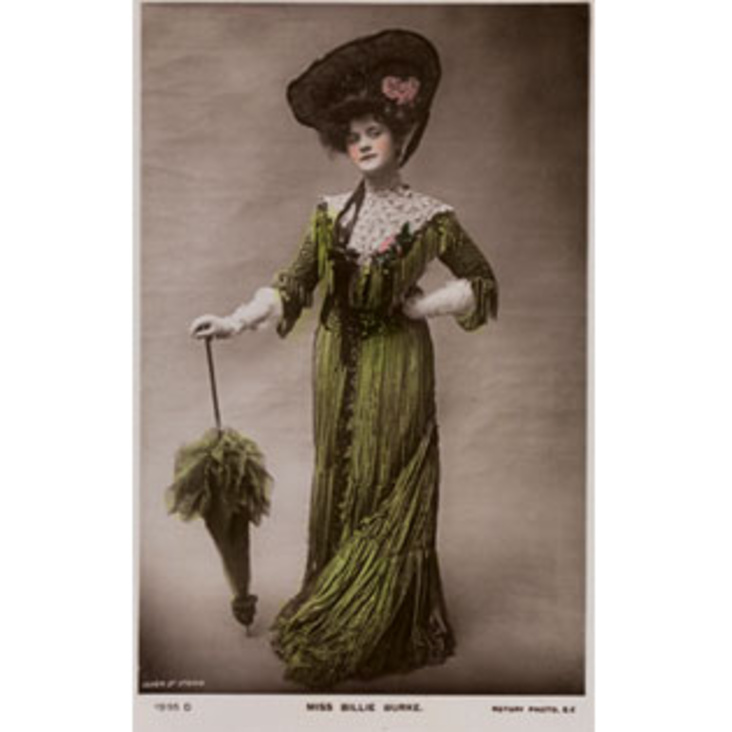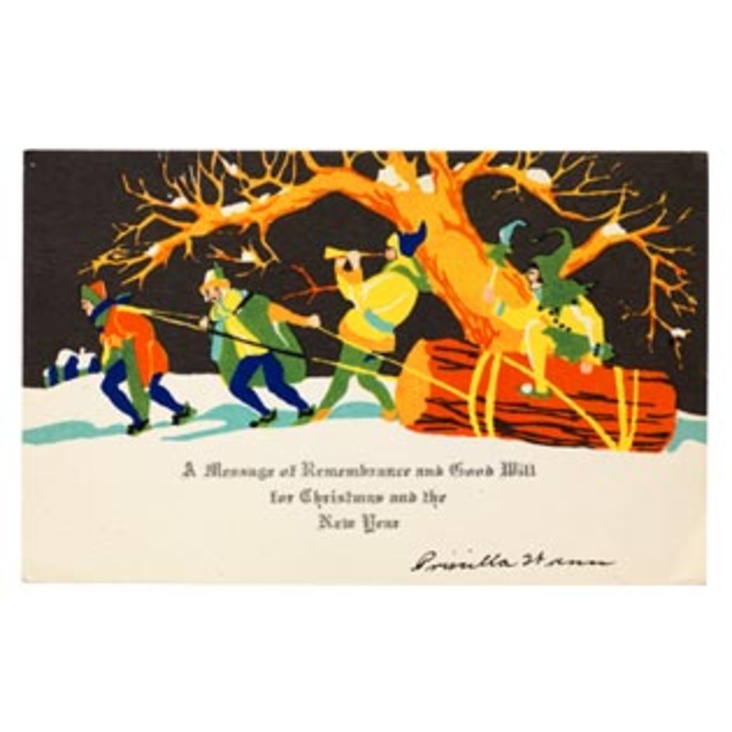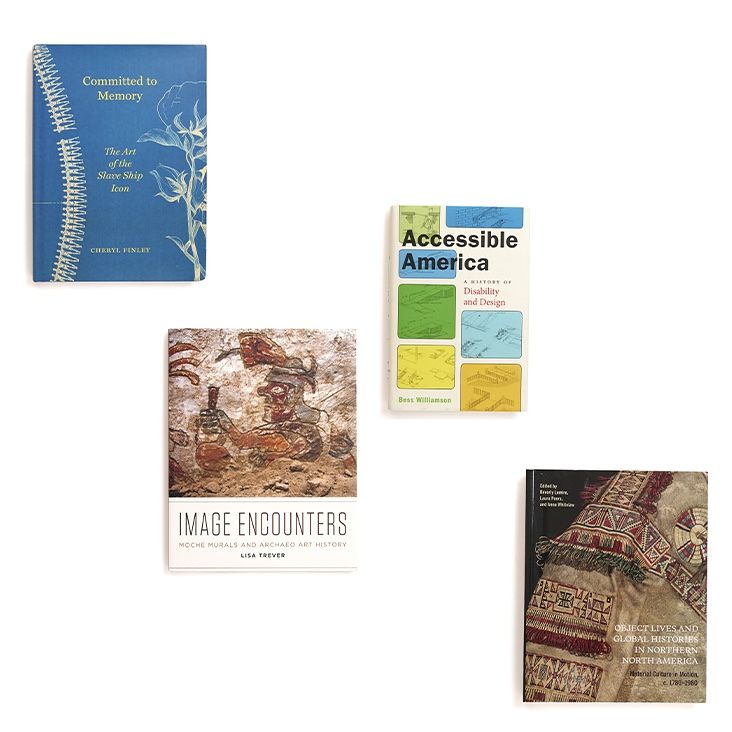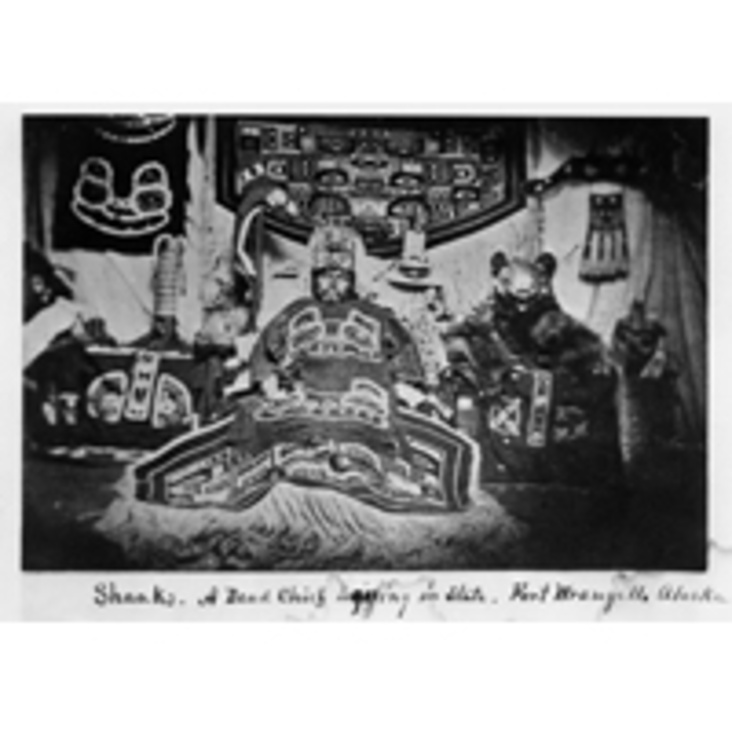Photograph by Edward Dossetter, 1881
From a glass plate
Donated by Israel W. Powell in 1885
Image 42263, American Museum of Natural History Library
British professional photographer Edward Dossetter captured this image of two Haida chiefs in Skidegate while he was employed on an 1881 inspection tour, the last of four such trips conducted by Israel W. Powell, the Superintendent of Indian Affairs for British Columbia. On these voyages, Powell documented Native cultural practices while promoting assimilation to Western modes of life. His annual reports reflect this professional duty: in the 1881 report, he lauds a local reverend (and, by extension, himself) for converting the nearby Massett people “into a better and more Christian mode of living,” pointing to the removal of traditional above-ground graves as proof of this conversion.1 Dossetter’s photographs (see also cat. 33), which were used to illustrate Powell’s report, may have been intended to perform as similar evidence for the success of cultural assimilation, indicated here by the appropriation and display of Western articles of clothing.2 These cultural signifiers, however, may have engendered different meanings for Native subjects, who often adopted symbols of foreign power to communicate their own internal cultural identities.
Frontally posed and staring back at the photographer, these two Haida men present an imposing image. Behind them, a raven’s beak projects from a monumental carved and painted totem pole—an example of the type which would soon no longer be produced in Skidegate owing to missionary discouragement of traditional cultural practices.3 This totem pole identifies the house as that of Paul Nanadjingwas, possibly the man at the left in the photograph.4
Notably, both men are outfitted in Western clothing, which the Haida wore both as everyday apparel and in ceremonial contexts.5 The chief at the left wears a sailor’s cap of the type commonly worn by marines of the British Royal Navy since the nineteenth century, identifiable by the brass badge consisting of a globe surrounded by laurel branches and surmounted by a crown and lion (fig. IIIa). The Native interest in Euro-North American animal motifs may suggest that a correlation was made to the display of family crests (see mask, cat. 18). The man on the left also wears a close-fitting military topcoat with two rows of nine metal buttons spanning his torso from collar to waist; this too was a style of jacket commonly worn by the Royal Marines. A well-known photograph of Chief Albert Edward Edenshaw (see canoe model, cat. 29) taken nine years later features the famed and oft-photographed chief in remarkably similar apparel, down to the brass cap badge and jacket with similar buttons (fig. IIIb). All three men also prominently wield Western-style canes, perhaps a nod to the chiefly practice of holding speaker staffs.6 Such clothing and accessories could have been obtained through several channels. Trade represents one way that Western goods circulated in Native economies, and manufactured clothing was in high demand from the earliest days of European arrival. Positions and insignias of political or ecclesiastical rank were also sometimes granted by local colonial authorities to Native leaders to encourage their abstinence from traditional cultural practices, whether or not they had this effect (see also cat. 33).7
Why would Haida men of such high rank, at a time of intense cultural upheaval in Haida territory, choose to have themselves photographed in Western military garb? Perhaps the British rank indicated by the articles of clothing consolidated Native status in the eyes of fellow Haida, especially in the newly amalgamated village of Skidegate, where chiefs from multiple villages came together. Alternatively, the appropriation of Western cultural signifiers may have been a way of keeping colonial intervention at arm’s length, offering the semblance of assimilation while traditional cultural practice continued in secret. With this image, Powell may have been promoting the modernization of chiefs to his Canadian superiors while AMNH curators collected photographic documents of traditional carving, but the men pictured may have been looking both ways at the same time. The continuing illegibility of such images today speaks to their liminal position: between two worlds, both-and, neither-nor. [Chad Alligood]
[2] Joan M. Schwartz, “The Past in Focus: Photography in British Columbia, 1858–1914,” BC Studies 52 (Winter 1981–82): 10.
[3] As George MacDonald notes, Dossetter’s 1881 photographs document a period of intense cultural assimilation in Skidegate, indicating “the end of the erection of traditional monuments at the village. By the time photographer Richard Maynard made his trip to Skidegate in 1884, most of the old houses had been pulled down or were in ruins, and many poles had fallen.” George MacDonald, Chiefs of the Sea and Sky: Haida Heritage Sites of the Queen Charlotte Islands (Vancouver: University of British Columbia Press, 1989), 37.
[4] Richard F. Garner, Haida and Tsimshian A Photographic History (Ottawa: Publications Division of the National Museums of Canada, 1972), 3. According to Robin K. Wright (personal communication), George MacDonald incorrectly identifies the house in this photograph in Haida Monumental Art: Villages of the Queen Charlotte Islands, as House #13, or Grizzly Bear house, which was owned by chief Tom Collinson (MacDonald, Haida Monumental Art, 47). This misidentification is puzzling given that MacDonald goes on to describe House #21 as having a tall house pole featuring a raven crest “with a long protruding beak supported near the end by a small human figure” (ibid., 51), which describes the pole in this image.
[5] Douglas Cole and David Darling, “History of Contact,” in Wayne P. Suttles, ed., Handbook of North American Indians, vol. 7, Northwest Coast (Washington: Smithsonian Institution, 1990), 122.
[6] It is possible, too, that the similar Western garb of Nanadjingwas and Edenshaw reflected an ongoing chiefly rivalry between the two men that also played out in other material realms of status display. The base of Nanadjingwas’s totem pole, pictured here, depicts an upside-down human figure intended to shame Edenshaw’s son for slighting Nanadjingwas. For more on this rivalry, see Garner, Haida and Tsimshian, 3.
[7] Alternatively, such clothing may have been pilfered in episodes of colonial conflict. Albert Edward Edenshaw’s cunning history of interfacing with Western visitors provides us with such an avenue of inquiry. In 1852 the American schooner Susan Sturgis, with Edenshaw as a co-pilot, was plundered by a group of 150 Massett men, who pillaged the vessel’s gold and silver and stripped the whites of their clothes. Edenshaw’s likely complicity in the affair was never conclusively proven, but his potential share in the spoils provides an additional valence to the display of Western military garb in such photographs. For more on this incident, see Barry M. Gough, “New Light on Haida Chiefship: The Case of Edenshaw 1850–1853,” Ethnohistory 29, no. 2 (Spring 1982): 133.












